Cold Email Templates that Get Responses
Be sure to check out our previous post, the first in this series: How to Get More Responses From Cold Emails
It’s tough to get people’s attention these days.
Baydin did some in-depth analysis on the e-mails sent through their Boomerang tool, and they came to some surprising conclusions. Out of five million e-mails analyzed, they found that on average, we get 147 e-mails per day, spend about 3.2 seconds on each one, and delete 80% of them in under three seconds.
On top of that, some of the e-mails we get require substantial work: just 12 messages can take up almost 90 minutes of our day.
This means that it’s getting harder and harder for cold e-mails to stand out.
If everyone is getting bombarded with new messages every day, delete the majority of them within a few seconds, and spend over an hour on a small number of highly important e-mails, then it’s going to take more work for salespeople to make prospects realize the importance of responding to their messages.
But despite all that, e-mail is still the best platform for making sales.
For one, e-mail is inexpensive and sees ROI relatively quickly. You don’t have to shell out hundreds of dollars like you might have to if you were testing paid traffic ads, or spend months of time waiting to get results like you would if you were creating content. According to research by Forrester:
85% of U.S. retailers consider e-mail marketing one of their most effective strategies for customer acquisition.
Additionally, e-mail can easily be customized to your specific audience, and personalization drives conversions. Platforms like Facebook have great targeting capabilities — and you can get specific with the words you use in your content to target the right people — but with e-mail you can personalize it at the individual level.
For B2B marketers, e-mail is the most effective tool of all. According to Web Marketing Pros, 40% of marketers rated the leads generated through e-mail marketing as the highest quality of all.
Email works — but only for those who know how to do it right.
Many of us know the pain of receiving dozens of spam e-mails every day. We delete them without even reading them, but they’re still annoying.
The key to writing a good cold e-mail that gets a response is understanding the psychology of your prospects before you start blasting out e-mails.
Learn More: How I Got A 333% Increase In Cold E-mail Response Rates
Here are a couple of things to keep in mind:
Sell to the Individual
Many salespeople forget that they’re not selling to a corporation. They’re not selling to some vague entity. They’re selling to people. There’s a real live human being on the other end reading your e-mails (or not!) with the same emotions and feelings that we all have.
Marketers and salespeople tend to overlook this fact and instead shoot off robotic templates that sound impersonal and don’t mention what’s in it for the individual at the other end. As a result, they get deleted.
When you take the time to think about what the person at the other end really wants (i.e. higher status, more revenue, a solution to their problem, etc.), they’ll feel like you really understand them and their specific situation — which is the key to getting any sale.
Understand Their Workflow
For most salespeople, their entire day revolves around the pitches that they’re sending out. It’s easy to assume that your prospects pay the same amount of attention to your e-mails as you do. But in reality, your message is just a small blip in their day.
Jill Kornath painted an accurate picture about this in an article called Example of a Really Bad Cold Call Email — just imagine that you’re the final decision maker to adopt new software products for your company.
You’re extremely busy.
An important customer is upset with you.
A valuable employee just left.
You’ve got a busy day ahead.
And then you just happened to click on someone’s cold e-mail.
If you were reading one of your own cold e-mails, would you keep reading? Or would you send it to the trash as fast as you could?
In this article, I’ll go through a few proven cold e-mail templates that get responses — based on psychological principles.
E-mail Templates that Get Responses
1) Before-and-After
Psychologists know that human beings are motivated by two things: pain and pleasure. More specifically, seeking pleasure and avoiding pain.
By writing an e-mail that illustrates the prospect’s current “painful” situation (i.e. a problem they have), shows them what it would feel like to solve that problem, and then dangles the solution (i.e. the path to pleasure) in front of them, you evoke emotions that boost the likelihood of getting a response.
For example, here’s an e-mail that was sent from a sales rep that hit all these points:
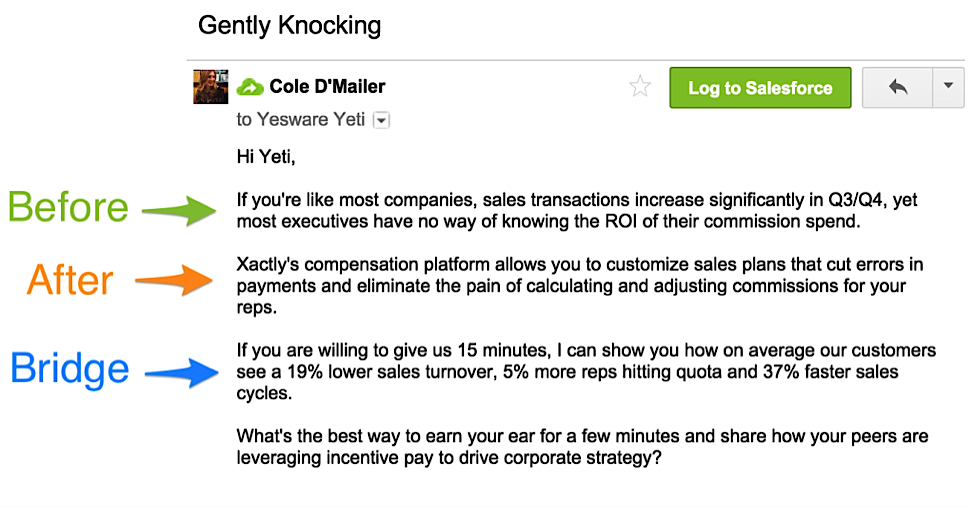
Source: Yesware
Notice how he immediately dives into the pain point of his prospect: “…sales transactions increase significantly in Q3/Q4, yet most executives have no way of knowing the ROI of their commission spend.”
Then he talks about how his company solves that problem. Finally, he closes with a CTA asking to schedule a call.
Learn More: How To Create A Killer Behavior-Based Email Campaign (Plus The Exact Tools & Tactics!) [podcast]
2) Twist-the-Knife
According to Psychology Today, our brains are more motivated by avoidance of pain than by pursuit of pleasure.
“Twisting the knife” is about agitating the prospect’s pain points so that they feel it at a deep, visceral level. E-mails that twist the knife first identify a pain point, then agitate it, and finally offer the solution.
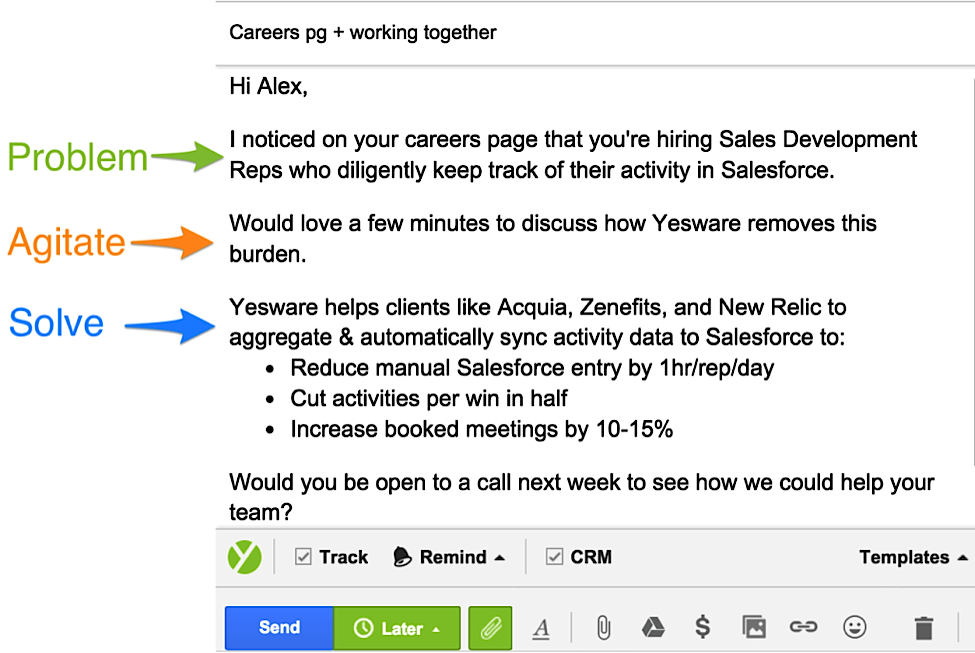
Source: Yesware
In the e-mail above, the salesperson specifically mentions the problem the company is facing. In the same sentence, he’s also making the e-mail sound more personalized to the recipient because he’s shown that he did his research before sending it out.
Then he mentions that his company’s software could remove the burden of data tracking in Salesforce and includes some social proof.
Finally, he closes with the CTA.
3) AIDA
AIDA is one of the most classic sales frameworks that exists today.
The framework consists of four parts: Attention, Interest, Desire, and Action.
The first part of the e-mail should grab your prospects’ attention. Remember a couple of things: 1) they’re busy, and they probably opened your e-mail during a short break in their day, and 2) most people delete e-mails in just a few seconds.
The second part of the framework is interest. You need to give prospects a reason to read further.
Desire is the third step of the framework, and its purpose is to help prospects understand how your offer could help them in a real way.
Lastly, you need a strong call to action — something that pushes your prospects to take the next step and move them down your sales funnel.
Read More: Step by Step Guide: How to Build a High Quality Marketing Funnel
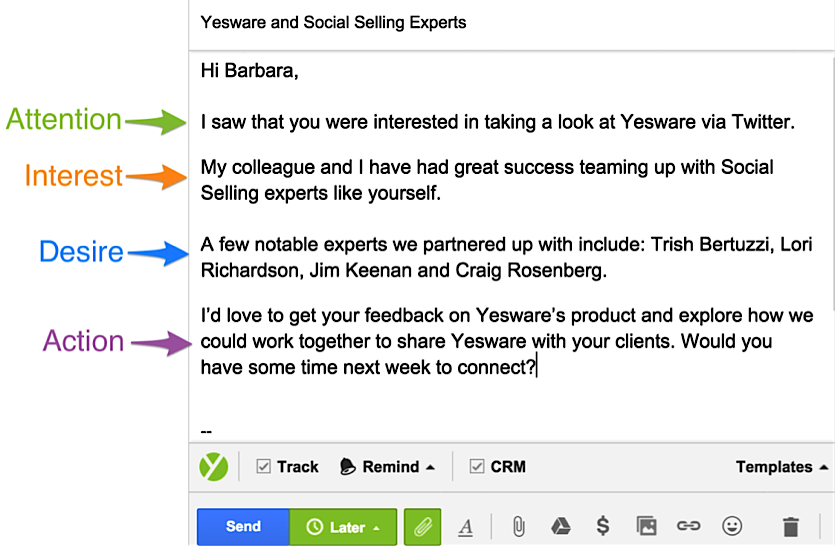
Source: Yesware
In the e-mail above, the salesperson grabs the prospect’s attention by mentioning that they were already interested in checking out the product via Twitter. Interest is generated by showing the prospect that the sales team has already had success working with others who are very similar to her — this also demonstrates social proof.
Desire is built even further by mentioning specific names that the prospect would likely recognize. And finally, the call to action is asking for a time to schedule a call.
Understanding Your Prospect’s Specific Situation
People like to think that they’re special. We often believe that our problems are unique and we look for someone who demonstrates that they really “get” our specific situation. So even if most companies in your industry can solve your prospect’s problems effectively, the one who communicates the sales pitch in a specific, “tailored” way is the one who will ultimately get the sale.
That’s what happened with Iris Shoor, co-founder of Takipi, who got meetings at LinkedIn, Twitter and GitHub through a single e-mail.
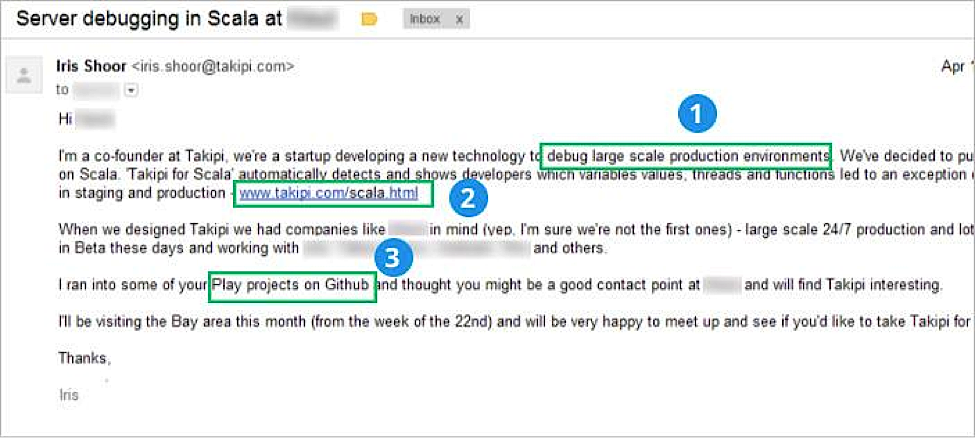
Source: Criminally Prolific
Shoor starts off the e-mail talking specifically about what her company does: debugging large scale production environments. She also knew that at LinkedIn and Twitter they used Scala, so she used that information to craft her next couple of sentences to make it more specific.
Lastly, she shows that she’s done even more research by referencing some of the prospect’s projects on GitHub, and why she thought that the prospect would be a good point of contact based off of that.
The more specific you can make your e-mail, the more your prospect will feel like your solution is a “tailored fit” for them — and that increases your response rates.
Establish Credibility
John Corcoran from the Art of Manliness wanted to interview Noah Kagan about his lessons learned from the personal failures and setbacks he had.
Noah Kagan runs OkDork and SumoMe, both of which are hugely popular sites. He likely gets hundreds of e-mails every day, along with tons of interview requests since he’s a high profile influencer in the marketing world.
Getting an interview with Noah through a cold e-mail isn’t easy.
But John managed to do it anyway:
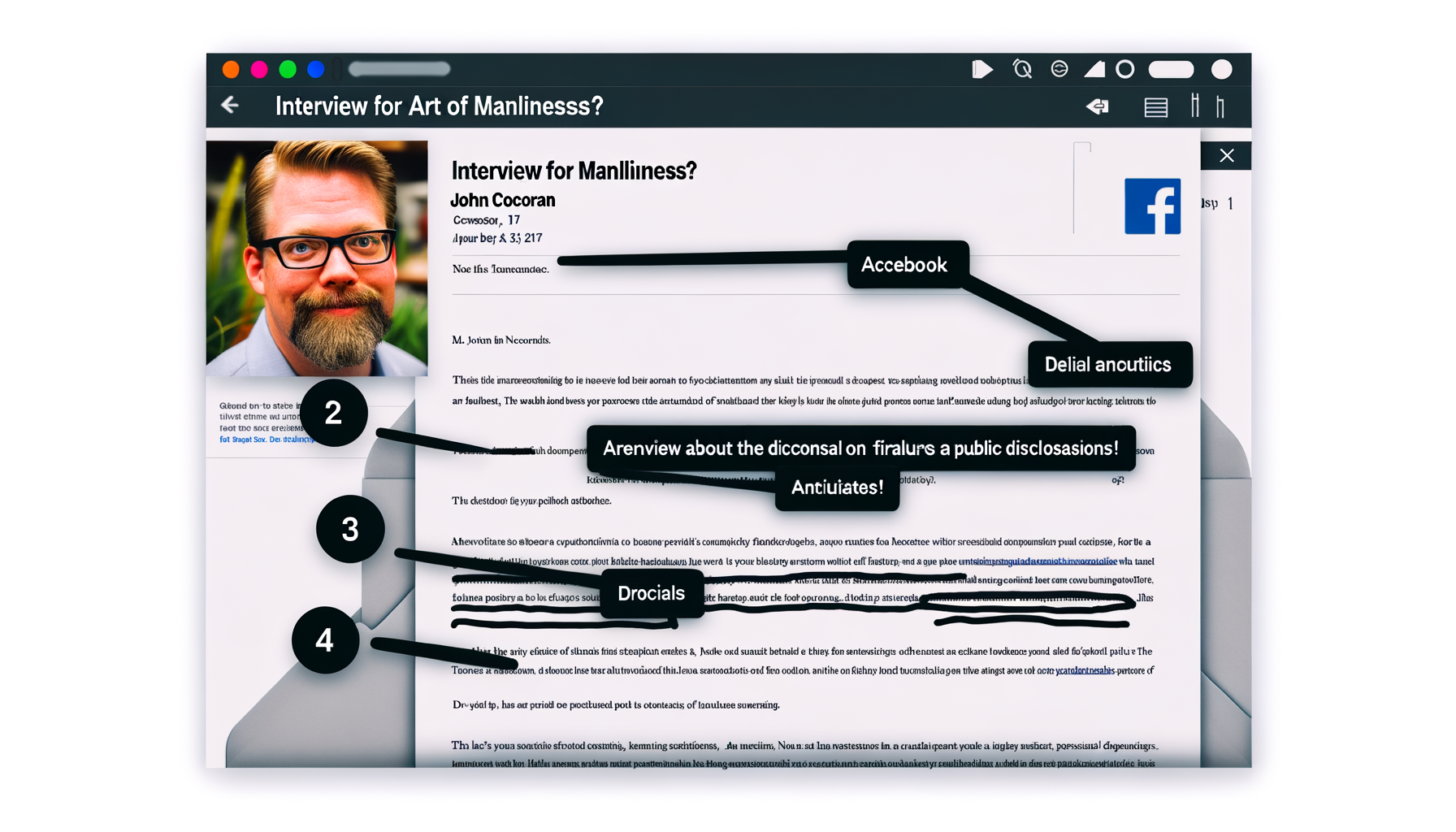
Source: Criminally Prolific
First, he starts off mentioning an interaction he had with Noah on a different platform. By mentioning some previous point of contact or a referral, you can increase your response rates by not coming off as a complete stranger.
Then he quickly mentioned that he was only asking a very low commitment request — he just wanted to interview Noah for 5-7 minutes. One of the biggest fears busy people have is wasting their valuable time talking to random people.
Next, John name drops a couple of people that Noah is friends with to add some more familiarity.
And finally, he closes off on a personal note (how much he loves tacos) because he knows how much Noah loves them, too — which further shows that he did his research.
Take Time to Personalize It
Bryan Harris from Videofruit wrote the best cold e-mail pitch that HubSpot ever received. There are a lot of things that he did right, and most of it just comes down to putting in extra time to personalize the message.
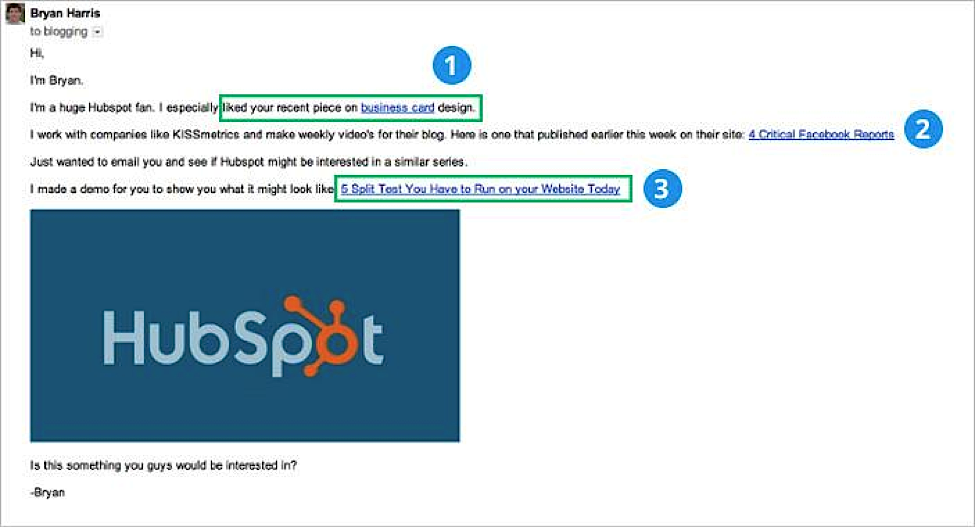
Source: Criminally Prolific
First, Bryan references a specific post on the HubSpot blog to show that he has done his research into the company. It becomes immediately clear that he’s not just spamming out generic templates to random companies, but that he’s actually taking the time out to do his research.
Next, he references one of HubSpot’s competitors, KISSmetrics, and says that he makes videos for them. This builds credibility with HubSpot, and it also creates the impression that any offer Bryan makes will be more of a “tailored fit” for them because of the fact that he’s worked with one of their closest competitors.
Finally, he closes with a demo video that he made specifically for them. Not only does this add massive value for the recipient, but it also shows how invested he is in making the relationship work out. Creating a demo takes quite a bit of time.
It also helps HubSpot visualize what the final product would look like, which makes them more likely to move towards a sale.
That’s why Ginny Soskey, content strategy manager for HubSpot, called this the best cold e-mail pitch she had ever received.
Conclusion
Even though e-mail inboxes are getting more and more crowded with more and more marketers competing for attention, it’s still the best platform on which to do sales.
There’s no other platform where you can own the relationship with your audience. There’s no other platform where you can create hyper-targeted, personalized messages for each person you’re reaching out to. There’s no other platform that lets you build as close a relationship with someone over time.
The opportunity is there, and those who understand the psychology of prospects and take the time to personalize their messages reap the benefits of cold e-mail.
When everyone else is spamming out a thousand e-mails with the same generic subject lines and body copy, you’ll know how to do deeper research into your prospects to figure out exactly how to grab their attention and ultimately get them to take the action that you want them to take.
Dive Deeper:
Which of the above templates will you use? Let us know in the comments below.




